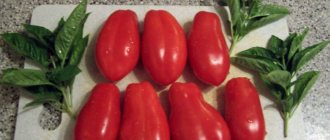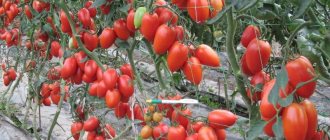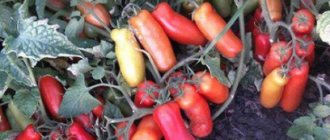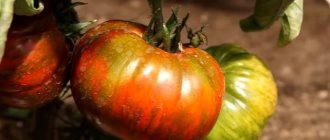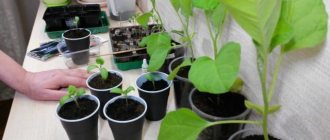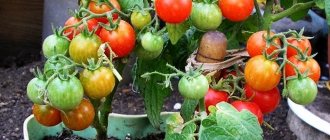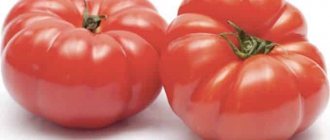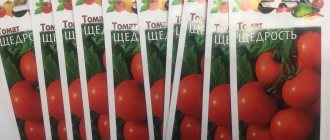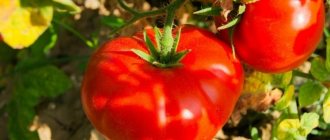» Vegetable growing » Tomatoes » Growing tomato Honey fingers
0
605
Article rating
Vegetable growers who grow tomatoes look for new varieties every year for cultivation in their summer cottages. One of the varieties of tomatoes that are classified as small-fruited varieties is the Honey Fingers tomato. The hybrid appeared relatively recently (2010), but has already gained many fans.
- Growing seedlings
- Seedling care
- Planting seedlings in the ground
- Care
- Loosening and fertilizing
- Diseases and their prevention
- Reviews from gardeners
Growing Tomato Honey Fingers
Taste qualities of fruits
The description of the tomato Honey Fingers F1 matches the photo. Tomatoes are cylindrical in shape with a pointed tip. The variety got its name due to the elongated shape of the fruit. The weight of the fruit is 60-80 g. The color of the tomato skin is yellow; when fully ripe, orange stripes appear on the surface. There are 2 or 3 chambers inside. The pulp is juicy, yellowish in color. Dry matter content 4-6%.
The hybrid variety is ideal for fresh consumption. The increased sugar content gives the pulp a honey taste. Due to their bright color, vegetables are used to decorate appetizers and salads. The hydride is suitable for canning in its entirety. However, it is not recommended to choose tomatoes of the Honey Fingers F1 variety for making ketchups and juices, since the yield of the finished product will be small due to the small mass of the fruit.
Attention! The harvested crop can easily be transported and can be stored for a long time.
Detailed description of the variety
The most basic characteristic for vegetable growers is that the variety is classified as indeterminate. Such tomatoes do not have a growth stop point and continue to constantly increase in size. The lifespan of the plant exceeds a year, so the harvest can be obtained throughout the entire period. To collect as many Honey Fingers as possible, it is recommended to grow the variety in heated greenhouses. Basic indicators:
- Maturing period. Tomato Honey Fingers f1 is a mid-season variety. From the moment of planting to harvesting, no more than 3 months (95–105 days) pass.
- Appearance of the bush. The height of an adult plant reaches 1.8 m and above. The bush is standard, very decorative. Carpal type hybrid.
- The leaves of the variety are not quite “tomato” looking. They are narrower and not too often located on the stems. The stems are more covered with clusters of fruits.
- The brushes are numerous and arranged alternately on the stem. One contains from 5 to 10 fruits.
If you plant Honey Fingers in open ground, the height of the bush will be less. However, the tomato will have to be tied up so that the stem does not break from the load of fruit. The stem will also develop stronger in sunlight and fresh air.
Description and taste of fruits
According to reviews, it is the characteristics of the Honey Fingers tomato fruit that are the main criterion for the popularity of the variety. They have the original shape of an elongated cylinder and are small in size.
At the end of each tomato there is a small “spout”. The weight of one tomato ranges from 70-80 g, the color of the tomatoes is yellow, sometimes there are orange stripes on the skin.
The pulp of the fruit is juicy yellow.
It contains a high content of sugars, which gives ripe tomatoes a honey taste. In a transverse section, 2-3 seed chambers are visible.
The fruits are used in a variety of ways. Honey Fingers look great in fresh salads and preparations. Extraordinary color and original size decorate any dish. The pickled variety has excellent taste.
Important! Tomato Honey fingers should not be used for making juices and ketchups.
Firstly, the variety does not have a very good color for such blanks. Secondly, the small size of the fruit gives a small yield of the finished product, which is not entirely effective.
Pros and cons of the variety
The strengths of the Honey Fingers F1 variety are present in the description of the tomato.
Advantages:
- fruiting extended over time;
- high productivity;
- transportability;
- sweetness of the pulp;
- possibility of long-term storage;
- resistance to fungal diseases;
- simultaneous ripening of fruits.
Tomato Honey fingers F1 is a relatively new variety, so not all vegetable growers were able to exchange opinions in reviews and post photos of bushes. Disadvantages of yellow tomatoes:
- the need for pinching and tying;
- It is not possible to use collected seeds.
If you follow the recommendations of agricultural technology from the originator of the variety, the fruits will exactly correspond to the declared characteristics.
Rules for planting and care
The Honey Fingers variety is recommended to be grown in seedlings.
To get a decent harvest of tomatoes, you need to correctly carry out all stages of cultivation:
- Preparation and sowing of seedlings.
- Caring for tomato seedlings.
- Planting in a permanent place (greenhouse or vegetable garden).
- Caring for adult plants.
- Harvesting and processing.
Each stage has its own characteristics and nuances.
Sowing seeds for seedlings
Initially, you should calculate the time for sowing seeds for seedlings for a specific region. In addition to the recommendations of the originator of the variety, it is good to use the tips of the lunar calendar. It is important to consider in what soil you plan to grow Honey Fingers. The optimal time is considered to be the first ten days of March.
- Prepare soil and containers for seedlings. It is best to take a ready-made mixture for seedlings. If you have the opportunity to prepare your own, you will need to mix equal amounts of humus, peat, garden soil, and half the dose of sand. Then add wood ash and mineral fertilizers. Mix the mixture for tomato seedlings thoroughly and pour in a disinfectant composition for disinfection.
- Wash the containers with a solution of potassium permanganate, dry, and fill with soil mixture.
- Soak tomato seeds in a growth stimulator (according to instructions).
Sowing can be done in two ways:
- Make shallow furrows, place tomato seeds, and level the soil.
- Carefully place the seeds on the surface of the soil mixture and cover with a 1 cm thick layer on top.
Moisten the crops with a spray bottle and cover with film until shoots appear. It is important to maintain the temperature in the range of + 20-26 °C. As soon as shoots appear on the surface, reduce the temperature to + 20 °C during the day and + 12 °C at night. It is important to maintain normal temperatures. Make sure that the plants do not overheat, otherwise the seedlings will stretch. Excessive cooling will lead to diseases and death of seedlings.
During the growth period of seedlings, it is necessary to monitor the level of soil moisture and take measures to ensure that a crust does not form on the surface. It is enough to water tomato seedlings 1-2 times a week. It is best to feed with liquid ready-made complex formulations for vegetable seedlings. Fertilizing must be combined with watering. The photo shows healthy tomato seedlings Honey Fingers:
Transplanting seedlings
When the seedlings form 5-7 true leaves, they are ready for transplanting.
You can grow Honey Fingers in:
- greenhouse;
- open ground;
- film greenhouses.
For midland regions, deadlines must be met. The first ten days of June - open ground, mid-late May - greenhouse, end of April or beginning of May - greenhouse.
The variety must be planted according to a certain pattern. For 1 sq. m you can place no more than 4 plants. After transplantation, the seedlings must be watered and shaded from the sun. It will take 10-14 days for plants to adapt.
Tomato care
The basic rule for a gardener is to create optimal conditions for tomatoes. Honeyfingers need warmth and light. Watering is regulated depending on weather conditions and soil conditions. The best time to water plants is in the evening after sunset.
You can start feeding the plants only after they have taken root. The first time you need nitrogen components. For honey fingers, it is good to use ammonium nitrate or herbal infusion. The next feeding is needed at the time of flowering, then during the formation of ovaries. Complex mineral fertilizers with phosphorus and potassium components are added to these phases.
It is recommended to form a bush with 1 or 2 stems. In this case, it is necessary to remove the side stepchildren; this will have to be done regularly. It is important not to allow the stepson to grow beyond 10 cm. Tying up the bushes is also a necessary measure. It protects the stems from breakage during the period of abundant fruiting.
To prevent the spread of diseases, preventive treatments with fungicides are necessary. With regular prevention, spraying with biological products is sufficient for Honey Fingers.
If signs of phomosis appear on the plants, immediately treat them with Hom, reduce the amount of nitrogen fertilizers and reduce the frequency of watering. Against dry spotting you can use “Consento”, “Tattu”, “Antrakol”. The main pests of Honey Fingers tomatoes are the rusty mite (“Bison”) and the whitefly (“Confidor”).
Agricultural technology of tomatoes Honey fingers
The main rule when growing tomatoes Honey Fingers F1 is warmth and light. Therefore, the best place for planting plants is a greenhouse. Requires a consistently high temperature for growth. The most commonly used method is the seedling method.
Growing seedlings
Planting seeds of the mid-early variety Honey Fingers F1 usually takes place from March 10 to March 20. Young seedlings are transplanted into the main soil 60 days after seedling germination. For seedlings, prepare a planting container and soil. You can use plastic trays or individual cups. It is better to buy a ready-made mixture for seedlings as a substrate.
A couple of hours before the intended procedure, the planting material must be soaked in a growth stimulator solution, following the instructions. Next, distribute the seeds over the surface, and then evenly sprinkle with a 1 cm thick layer of soil. Spray the top with water from a spray bottle and cover with film.
The box with future seedlings must be placed in a warm place with a temperature of + 22-24 °C. When the sprouts hatch, the cover is removed and the container is transferred to the light. The temperature is reduced to + 20 °C. During the development of seedlings, it is important to adhere to the temperature regime. If it's hot, the plants will stretch out. Hypothermia can lead to infections and death of seedlings.
Water procedures for tomatoes Honey Fingers F1 must be carried out every two days. Fertilize with complex liquid, nutrient preparations for seedlings. Watering can be done in conjunction with fertilizing.
Landing rules
Picking of tomato seedlings Honey Fingers F1 is carried out at the stage of formation of 2-3 leaves. For seedlings, hardening is considered a useful procedure. This will strengthen the immune system and ensure rapid survival of the culture.
Tomato seedlings Honey Fingers F1 are ready for transplanting when 5 leaves are formed. Depending on the area of cultivation, the following deadlines should be observed:
- the last ten days of April and the beginning of May - transplant into a greenhouse;
- from the second half to the end of May - a greenhouse;
- the first days of June – beds in open ground.
Immediately after planting, seedlings should not be left in the sun. It needs to be shaded. Adaptation period – 2 weeks.
Attention! When choosing a site for Honey Fingers F1 tomatoes, crop rotation must be taken into account. It is preferable to plant where dill, carrots, zucchini, squash, and cabbage grew last year.
Transplanting hybrid seedlings Honey fingers F1.
- Holes are formed based on the size of the root system.
- 10 g of superphosphate is poured onto the bottom.
- The plant is sprinkled with soil up to the lower leaves. Press firmly, but do not compact the earth.
- Warm water is poured over the top.
- After ten days, the weak soil is treated with a solution of potassium permanganate.
Important! Disinfection helps prevent the occurrence of late blight.
Watering and fertilizing
Water procedures are carried out in the morning. After all, in the afternoon the temperature drops noticeably. Such an irrigation system will prevent the formation of condensation in the greenhouse and, accordingly, the development of late blight and blossom end rot. On average, tomato bushes of the Honey Fingers F1 variety are moistened 2-3 times a week.
You can start fertilizing plants only after they have taken root. In the first stages, nitrogen preparations are used for rapid growth. Ammonium nitrate or herbal tincture is ideal. The second and third procedures are performed during the flowering period and the formation of ovaries, respectively. Fertilizers with potassium and phosphorus components are used as nutrients.
Pinching and tying
The pinching procedure promotes unhindered penetration of sunlight to the fruits and their rapid ripening. The stepson should not be allowed to grow more than 10 cm. Excessive foliage interferes with the air exchange of the bush, which leads to the occurrence of infectious diseases.
The next necessary step in the process of caring for Honey Fingers F1 tomatoes is tying. Installing supports and attaching shoots to them will help the stem not to break under the weight of ripening fruits.
Formation
In reviews, experienced gardeners recommend forming two stems from F1 Honey Fingers tomatoes. This involves removing side branches throughout the growing season. They completely tear off the lower foliage up to the first brush, tear off the stepsons.
Protection from diseases and pests
Hybrid tomato Honey Fingers F1 is considered a disease-resistant variety. However, due to excessive use of nitrogen fertilizers or waterlogging, symptoms of Phoma may appear. Affected fruits should be destroyed and the shoots should be treated with Hom.
Another disease that causes problems for yellow-fruited tomatoes is dry spot. The fight against the disease consists of spraying the bushes with chemicals “Antrakol” and “Tattu”.
In greenhouses, Honey fingers F1 tomatoes suffer from whitefly. The insecticide “Confidor” is used against this pest. The rust mite is no less dangerous. You can get rid of it by spraying with the preparation “Zubr”.
Advice! When growing a hybrid variety of yellow tomatoes, preventive spraying with biological products will not be superfluous. Systemic fungicides are used to prevent spread.
Growing seedlings
They prefer growing Honey Fingers tomatoes in seedlings. This allows the crop to become stronger and develop a viable root system before being transferred to a permanent location, which will allow it to quickly adapt to new conditions. The time for sowing seeds is early or mid-April.
The soil for seedlings must be fertile, crumbly, and disinfected. Garden soil, ash, humus, peat, sand or fine sawdust and complex fertilizers are added to it. It is not necessary to disinfect seeds before sowing: producers carry out a complex of their treatment in advance.
Sometimes the growth of planting material is additionally stimulated by soaking it in “Kornevin”, water with aloe juice, etc.
The seeds are placed in common containers or separate pots to a depth of 1.5-2 cm, carefully sprinkled with soil, and sprayed with warm water from a spray bottle. The boxes are covered with transparent polyethylene and sent to a warm but dark place until the sprouts appear.
Having noticed the first shoots, remove the cover from the container and transfer it to a well-lit place with a stable temperature (18-20 °C). Exceeding the norm of the thermal regime threatens to stretch the seedlings, and their hypothermia can provoke the occurrence of diseases and death of seedlings.
Tomato yield Honey fingers
Based on reviews, photos and stated characteristics, it can be argued that the Honey Fingers tomato is a productive variety. However, fruiting directly depends on planting density: per 1 sq. m it is recommended to plant no more than 4 plants. Lighting is equally important. The hybrid is not suitable for cultivation in northern regions where there is little sun.
Thus, from one bush one gets from 12 to 14 kg of fruits in greenhouse conditions. When grown in the garden, the yield is 5 kg of tomatoes per bush.
Important! The number of vegetables harvested is affected by the period of fruiting and care.
Varietal characteristics
The most sought-after characteristics of Honey Fingers are productivity, disease resistance and low maintenance. The variety has a very attractive quality - extended fruiting. The first harvest of ripe tomatoes is ready for harvest 95 days after planting. Then the fruits ripen gradually.
Tomatoes should be harvested as they ripen. Otherwise, the top ones will become overripe and lose their taste and elasticity. According to the description, the Honey Fingers tomato is very productive, as in the photo:
Vegetable growers harvest up to 14 kg from one bush during the season when grown in greenhouses. In open ground the yield is lower - about 5 kg per bush. The decrease in the indicator depends on the period of fruiting and growing conditions. In a heated greenhouse, tomatoes bear fruit much longer. It is also important to provide the variety with sufficient lighting.
The variety is rarely affected by major crop diseases. Diseases from which the plant needs to be protected are phomosis and dry spotting.
Honey fingers are very demanding in terms of lighting and heat. Therefore, they can be grown in open ground in the southern regions. The conditions of the middle zone, as well as the northern regions, are not suitable for such cultivation. Vegetable growers need to equip greenhouse areas and supports for tying.
Pros and cons of the variety
The hybrid is quite young. But many vegetable growers have already managed to grow the variety and share their impressions. Among the advantages of small-fruited tomatoes are:
- High stable yield.
- Duration of fruiting.
- Resistance to crop diseases.
- Excellent fruit taste.
- Ability to withstand transportation well.
- Keeping quality, possibility of long-term storage.
- Versatility of use.
